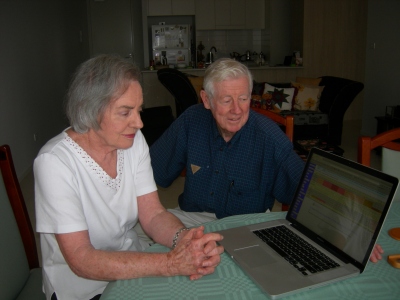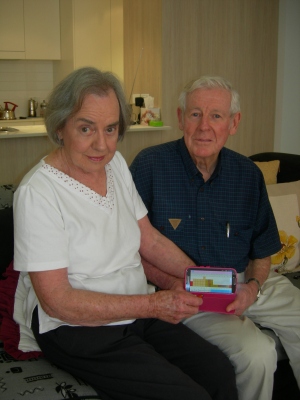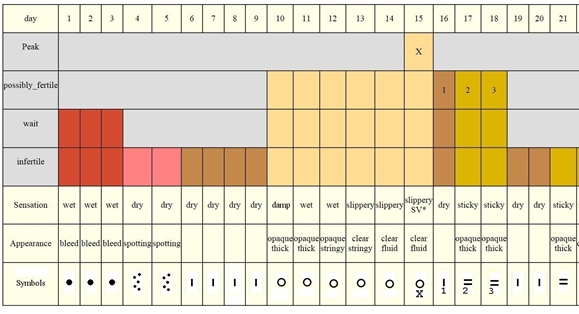Catholic Medical Quarterly Volume 65(2) May 2015
National fertility conference in Australia reveals new directions for natural family planning (NFP)
Audrey D Smith and John L Smith
 The National Fertility Conference, hosted by the John Paul II Institute
for Marriage and Family[1] in Melbourne Australia on 19-21 September 2014,
was a watershed for fertility awareness. The conference realised a vision
of Professor Nicholas TontiFilippini[2] that the three main fertility
awareness agencies[3-5], promoting the Creighton model[3], the
Sympto-thermal model[4], and the Billings model[5], could collaborate in a
conference emphasising their common goals. Professor Tonti-Filippini died
in November and his passing will be deeply felt by many who knew him.
The National Fertility Conference, hosted by the John Paul II Institute
for Marriage and Family[1] in Melbourne Australia on 19-21 September 2014,
was a watershed for fertility awareness. The conference realised a vision
of Professor Nicholas TontiFilippini[2] that the three main fertility
awareness agencies[3-5], promoting the Creighton model[3], the
Sympto-thermal model[4], and the Billings model[5], could collaborate in a
conference emphasising their common goals. Professor Tonti-Filippini died
in November and his passing will be deeply felt by many who knew him.
The primary theme of the conference was infertility and restorative reproductive medicine, with the main sessions on the first day devoted to medical restorative approaches for the treatment of infertility and sub-fertility. This was followed on the last day by a stream on the ethics of restorative reproductive medicine.
Dr Phil Boyle, a fertility specialist from Galway, Ireland, said that infertility is usually a consequence of multiple chronic conditions (e.g. endometritis, progesterone/oestradiol deficiency, hostile cervical mucus, clinical endorphin deficiency, food intolerance, polycystic ovaries, clinical adrenal fatigue, endometriosis, reduced sperm mobility/low spermatozoon count) rather than a single acute condition. Natural Procreative Technology (NPT) aims at diagnosis and treatment of the multiple factors associated with infertility[6]. Preliminary data shows that NPT produces a better outcome[7] (in parental and baby health) than IVF where births are most likely to be achieved in the cases of blocked fallopian tubes and male infertility. Dr Luke McLindon from the Mater Mothers’ Hospital, Brisbane, Australia discussed a study[8] of sub-fertile women who used a fertility awareness based approach, including hormonal therapy, to achieve a pregnancy by natural conception. There is a general lack of knowledge about fertility amongst women, even amongst the infertile population. This is despite the experience in NFP agencies that fertility awareness, particularly that involving a properly maintained fertility chart, has helped many couples achieve the pregnancy that has previously eluded them. The study concluded that a fertility awareness based method appears acceptable amongst all women intending to naturally conceive a pregnancy.
Fertility Awareness (the basis of NFP) is one of numerous diagnostic tools used in NPT. The fertility awareness agencies have always been aware of the way some of the chronic conditions underlying infertility are evident in a fertility chart[9]. Thus the medical clinicians in NPT and restorative medicine are now familiar with at least one form of fertility awareness chart. Moreover, they rely on the fertility awareness agencies to impart the education in fertility awareness to the NPT clients. Thus there is an alliance beginning to form between the medical profession and the agencies. It was noted that much more work needed to be done to educate the wider medical profession about fertility.
Important monitoring tools in any assisted pregnancy focus on ovulation, for both its onset and occurrence. There is a need for a simple and cheap tool that can be used by the woman at home, thus avoiding the costly and inconvenient pathology of regular blood tests. The Brown Ovarian Monitor which measures urinary metabolites proved successful in this area, but there was a hiatus in its use following Professor Brown’s death in 2009. Associate Professor Len Blackwell (Massey University, NZ), a long time colleague of Brown, said that Professor Brown’s family has given him access to all Brown’s notes and material, and that he has now developed a dipstick-type system for testing the urine samples and he is working towards a hand held reader[10]. Dr Adrian Thomas, a Melbourne obstetrician/gynaecologist, described the results of his deployment of the Brown Home Monitor to patients, some in remote locations, as a convenient, reliable, inexpensive and simple method of monitoring the response to ovulation induction.
Dr Raffaella Pingitore, a Swiss Italian gynaecologist, began the conference on the evening of September 19 with an entertaining public lecture on ovulation, which conveyed its message by including role play by numerous participants from the audience.
There was an entire parallel stream on Christian Sexuality, presented by members of the John Paul II Institute on the first day. The presentations were excellent and reflected highly on the quality of the staff and researchers at the Institute.
Each of the main fertility awareness agencies conducted a parallel stream on the last day of the conference. A common venue for refreshment breaks and lunch during the entire conference facilitated good mixing among the delegates, that allowed the spirit of goodwill amongst delegates from the different agencies to flourish. Presentations in the parallel streams were aimed mainly at introducing newcomers to the methods, particularly by the use of case studies. The Creighton Model is firmly identified with the Fertility Care agencies, that mainly address infertility. The Billings Method fertility model is based on cervical mucus observations and associated patterns. The Sympto-thermal fertility model combines a mucus based observation with basal body temperature measurement, and optional cervical palpation. The latter two agencies are more balanced in their promotions for both types of user need (achieving and avoiding pregnancy).
An interesting and forward-looking presentation on promotion and communication for NFP was given by Anna Johnstone in the Australian Council of Natural Family Planning (Sympto-thermal Method) stream. Anna is married with two young children; she holds a Masters degree in Strategic Communication; she gained her accreditation as a clinical educator of the Sympto-thermal Method in 2013 and currently manages the NFP services in the Archdiocese of Canberra-Goulburn, Australia. Anna spoke of the impact of the digital media on the social and marketing landscape, particularly through the availability of mobile “apps”. Information is readily available and consumers now search for information based on their needs, as opposed to searching for particular brands (e.g. an NFP method). The implication is that NFP agencies should collaborate to develop a customer-centric product, with services offered to meet the different individual needs. Anna said good marketing now avoids high up-front costs, as is the case with current NFP services. There should be easier access to more professionally delivered information, priced for consumption by a wider mainstream audience.
Other marketing strategies include giving more away free, and exploiting the shift towards the consumption of natural foods, promoting NFP as a healthy alternative to hormonal medication.
 NFP
App on mobile phone
NFP
App on mobile phoneThe mobile “app” is a significant development in NFP that was not covered in the conference. These “apps” have emerged in recent years, and are still being questioned by most teachers of the methods, for several reasons. Overall, the experienced teachers in NFP have always taught face to face. More recently there has been some use of computer charting systems that allow the sharing of charts and discussion over the Internet. However, the older generation of teachers insist that fertility awareness can only be attained by making your own decisions in a context of listening, instructing and encouragement by a teacher. Underlying this is scepticism about e-learning, and that software algorithms are capable of interpreting fertility symptoms in all situations. Yet young women of Anna’s generation, for whom the phone “app” is the norm for the delivery of any information-based services, are quite happy to use fertility awareness “apps ”. This also suggests that there may be an untapped market using the digital media to convey fertility awareness to teenage women who are not sexually active.
The Billings Method agency used their stream to demonstrate Fertility Pinpoint[11], a web-based charting system. The presenters were at pains to point out that the system had been specified by a group of experienced teachers of the method, and that they had rejected many suggestions made by the technical team that has implemented the system. The advances are: (i) a web-based replication of the long- established hard copy charting system, (ii) a message system for communication between client and a teacher who is contracted independently of the system.
A shortcoming of the conference resulted from the organisers delegating to each fertility agency the programming of a stream dedicated to their method. One would hope that, at future conferences of this type, there could be some objective presentations that explored the differences in the methods with a view to advancing all the methods. Natural family planning would benefit if all the agencies placed more emphasis on research and development.
A simple example that could be explored to the benefit of all methods, without requiring any change to their underlying fertility models, is to exploit the power of the computer to visualise phenomena. Just think of the computer graphics that underlie the computer games that absorb so much of our children’s time. There is already a credible, simple example in billingsMentor® [12], a web-based interpretive “app” for the Billings Method that is freely available on the Internet. The fertility chart in billingsMentor® (Figure 1) is intuitive (no use of stickers or symbols with hidden semantics), and it conveys the fundamental characteristics of all the fertility models, by graphically depicting increasing and decreasing fertility between “infertile”, “wait”, “possibly fertile” and “peak”.
Figure 1. The computer generated chart of the first 21 days of a cycle as used in billingsMentor® 13. The colour map can be varied by the designer according to system requirements. There were calls expressed by several speakers during the conference for the formation of a collaborative organisation to further their aspirations. One hopes that this also extends to the fertility awareness agencies, that have much to gain from listening to ideas and research from outside their particular group.

References
- John Paul II Institute [Internet] 2001 [updated September 24 2014; cited September 28 2014]. Available from: http://www.jp2institute.org/
- Professor Nicholas Tonti-Filippini [Internet] 2012 [updated July 4 2013; cited September 28 2014]. Available from: http://www.jp2institute.org/About/Administration/Professor-Nicholas-Tonti-Filippini.aspx
- Australian Council of Natural Family Planning [Internet] 2013 [updated June 5 2014; cited September 28 2014]. Available from: http://www.acnfp.com.au/home.php
- Billings LIFE
[Internet] 2012 [updated Feb 22 2014; cited September 28 2014].
Available from: http://www.thebillingsovulationmethod.org/ - FertilityCare [Internet] 2002 [updated May 28 2014; cited September 28
2014]. Available from:
http://www.fertilitycare.com.au/ - Boyle P, Stanford J. NaPro Technology (Natural Procreative Technology) – a multifactorial approach to the chronic problem of infertility. Sveikatos Mokslai 2011; 21(3):61-68.
- Stanford J, Parnell T, Boyle P. Outcomes from treatment of infertility with natural procreative technology in an Irish general practice. Journal of the American Board of Family Medicine 2008; 21(5):375-384.
- McLindon L, Beckmann M, Flenady V, McIntyre H, Capman M. Women’s views of a fertility awareness and hormonal support approach to subfertility. Human Fertility 2013; 16(4):252-257.
- Vigil P, Raffaella P. The treatment of endocrine causes of sub-fertility. Paper presented at: National Fertility Conference; 2014 September 19-21; Melbourne Australia.
- Blackwell L. The Brown ovarian hormone monitor – into the future. Paper presented at: National Fertility Conference; 2014 September 19-21; Melbourne Australia.
- Fertility Pinpoint [Internet] 2013 [updated June 5 2014; cited September 28 2014]. Available from: https://www.fertilitypinpoint.com/
- Smith A, Smith J. billingsMentor: Adapting natural family planning to information technology and relieving the user of unnecessary tasks. The Linacre Quarterly 2014; 81(3):219-238.
- billingsMentor [Internet] 2009 [updated August 22 2014; cited September 28 2014]. Available from: http://www.billingsmentor.org/
